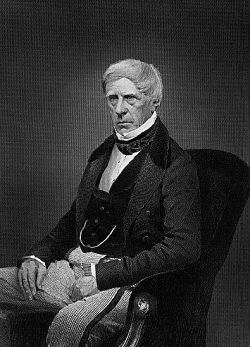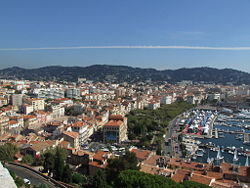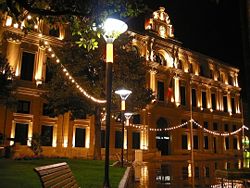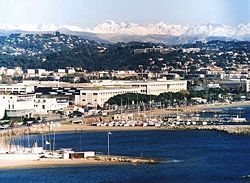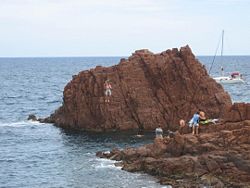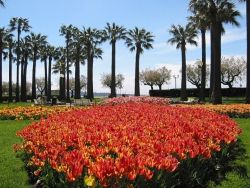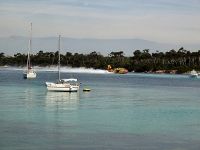Difference between revisions of "Cannes" - New World Encyclopedia
Mike Butler (talk | contribs) |
Mike Butler (talk | contribs) |
||
| Line 33: | Line 33: | ||
Size – land area, size comparison | Size – land area, size comparison | ||
Environmental issues | Environmental issues | ||
| + | |||
| + | [[Image:Marg2.JPG|thumb|View of the [[Île Sainte-Marguerite]], including the Fort Royal and the village of Sainte-Marguerite.]] | ||
| + | |||
| + | The Lérins Islands are a group of four [[Mediterranean]] [[island]]s off the coast. The two largest islands in this group are the [[Île Sainte-Marguerite]] and the [[Île Saint-Honorat]]. The smaller [[Îlot Saint-Ferréol]] and [[Îlot de la Tradelière]] are uninhabited. | ||
| + | |||
| + | |||
| + | The Île Sainte-Marguerite held a [[fortress]] where [[The Man in the Iron Mask]] was held [[captivity|captive]] for a time. | ||
| + | |||
| + | Under the [[French Revolution]], the Île Sainte-Marguerite and the Île Saint-Honorat were renamed the Île [[Jean-Paul Marat|Marat]] and the Île [[Louis-Michel Lepeletier|Lepeletier]], after secular martyrs. | ||
Districts | Districts | ||
| Line 41: | Line 50: | ||
There were civilisations in the Cannes area by the second century B.C.E. Ligurian tribesmen created a settlement there known as Aegitna. It was occupied by [[Phocaeans]], from central Greece, and [[Celts]]. The area was a fishing village used as a port of call between the [[Lérins Islands]]. | There were civilisations in the Cannes area by the second century B.C.E. Ligurian tribesmen created a settlement there known as Aegitna. It was occupied by [[Phocaeans]], from central Greece, and [[Celts]]. The area was a fishing village used as a port of call between the [[Lérins Islands]]. | ||
| − | In 69 C.E., the area became the scene of violent conflict between the troops of [[Othos]], a village in Karpathos, Greece, and Roman Emperor [[Vitellius]]. Roman tombs in the area suggest Romans had an outpost on Le Suquet hill. | + | In 69 C.E., the area became the scene of violent conflict between the troops of [[Othos]], a village in Karpathos, Greece, and Roman Emperor [[Vitellius]]. Roman tombs in the area suggest Romans had an outpost on Le Suquet hill. The Lérins islands were inhabited during Roman times. |
| + | |||
| + | The monks of the Lérins islands controlled the area in the fourth century. The Île de Saint-Honorat bears the name of the founder of [[Honoratus|Saint Honoratus]] founded the [[monastery of Lérins]], around the year [[410]]. It is in this monastery that [[Saint Porcarius]] lived and probably was killed during an invasion by [[Muslim]] sea raiders. According to tradition, [[Saint Patrick]], patron of [[Ireland]], studied there in the fifth century. | ||
| − | The | + | A fortified monastery was built between the eleventh and fourteenth centuries. The monastic community today lives in a monastery built during the nineteenth century. |
An attack by Muslim sea raiders in 891, who remained until the end of the 10th century, devastated the country around Canua. The insecurity of the Lérin islands forced the monks to settle on the mainland, at the Suquet. A castle was built in 1035 to fortify city, by then known as Cannes, to guard against Muslim raiders. Construction of two towers on the Lérin Islands was started at the end of the 11th century. One took a century to build, the other three. | An attack by Muslim sea raiders in 891, who remained until the end of the 10th century, devastated the country around Canua. The insecurity of the Lérin islands forced the monks to settle on the mainland, at the Suquet. A castle was built in 1035 to fortify city, by then known as Cannes, to guard against Muslim raiders. Construction of two towers on the Lérin Islands was started at the end of the 11th century. One took a century to build, the other three. | ||
| Line 65: | Line 76: | ||
==Government== | ==Government== | ||
[[Image:Cannes Town Hall .jpg|thumb|right|250px|Hôtel de Ville (The City Hall).]] | [[Image:Cannes Town Hall .jpg|thumb|right|250px|Hôtel de Ville (The City Hall).]] | ||
| − | Cannes is a commune of the Alpes-Maritimes département in the [[Provence-Alpes-Côte-d'Azur]] région of metropolitan (European) [[France]]. Cannes is governed by a municipal council and a mayor. The Alpes-Maritimes département is governed by a locally elected ''conseil général'' (general council) and a president. The conseil général passes laws on matters that concern the department; it is administratively responsible for departmental employees and land, manages subsidized housing, public transportation, and school subsidies, and contributes to public facilities. The [[Provence-Alpes-Côte-d'Azur]] région is governed by a directly elected regional council and a president. | + | Cannes, including the Lérins Islands, is a commune of the Alpes-Maritimes département in the [[Provence-Alpes-Côte-d'Azur]] région of metropolitan (European) [[France]]. Cannes is governed by a municipal council and a mayor. The Alpes-Maritimes département is governed by a locally elected ''conseil général'' (general council) and a president. The conseil général passes laws on matters that concern the department; it is administratively responsible for departmental employees and land, manages subsidized housing, public transportation, and school subsidies, and contributes to public facilities. The [[Provence-Alpes-Côte-d'Azur]] région is governed by a directly elected regional council and a president. |
Different levels of administration have different duties, and shared responsibility is common. For instance, in the field of education, communes run public elementary schools, while départements run public junior high schools and régions run public high schools, but only for the building and upkeep of buildings; curricula and teaching personnel are supplied by the national Ministry of Education. | Different levels of administration have different duties, and shared responsibility is common. For instance, in the field of education, communes run public elementary schools, while départements run public junior high schools and régions run public high schools, but only for the building and upkeep of buildings; curricula and teaching personnel are supplied by the national Ministry of Education. | ||
| Line 139: | Line 150: | ||
[[Category:Cities]] | [[Category:Cities]] | ||
| − | {{credit|Cannes|231453031|}} | + | {{credit|Cannes|231453031|Lérins_Abbey|200843838|}} |
Revision as of 03:54, 14 August 2008
Commune of Cannes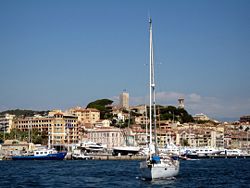
| |
| Location | |
| Longitude | 7.012753 |
| Latitude | 43.551347 |
| Administration | |
|---|---|
| Country | |
| Region | Provence-Alpes-Côte d'Azur |
| Department | Alpes-Maritimes |
| Arrondissement | Grasse |
| Mayor | Bernard Brochand (2001-2008) |
| Statistics | |
| Altitude | 0–260 m |
| Land area¹ | 19.62 km² |
| Population² (2007) |
70,400 |
| - Density (1999) | 3430/km² |
| Miscellaneous | |
| INSEE/Postal code | 06029/ 06400 |
| ¹ French Land Register data, which excludes lakes, ponds, glaciers > 1 km² (0.386 sq mi or 247 acres) and river estuaries. | |
| ² Population sans doubles comptes: single count of residents of multiple communes (e.g. students and military personnel). | |
Cannes (IPA: [kan], in Occitan Canas) is a city in the Alpes-Maritimes department in the region of Provence-Alpes-Côte d'Azur in southeastern France. It is one of the best-known cities of the French Riviera. It is a busy tourist destination and host of the annual Cannes Film Festival. The population was of 70,400 as of the 2007 census. Cannes is the home of numerous luxurious houses and mansions as well as many high-end gated communities. The city is also famous for its various luxury stores, fancy restaurants, and prestigious hotels.
Geography
The name may derive from "canna", a reed, because the shore was once covered with reeds. Cannes is located on the crescent of the Gulf of Napoule, backed by a line of wooded hills. La Croisette, the waterfront avenue lined with palm trees, is known for picturesque sandy beaches and for restaurants, cafés and boutiques. La Suquet, the old town, provides a good view of La Croisette.
Cannes has a Mediterranean climate. Temperatures in January range from 43°F to 55°F (6°C to 13°C), and in July 68°F to 81°F (20°C to 27°C). The city enjoys 12 hours of sunshine per day during summer (May to September), and despite the hot daytime temperatures, a Mediterranean breeze keeps summer evenings pleasant and cool. In winter (December to February) the weather is mild. Both seasons see a relatively low rainfall and most rain is during October and November, when 4.3 inches (110mm falls). Average annual precipitation is 21 inches (530mm).
Rivers and canals Size – land area, size comparison Environmental issues
The Lérins Islands are a group of four Mediterranean islands off the coast. The two largest islands in this group are the Île Sainte-Marguerite and the Île Saint-Honorat. The smaller Îlot Saint-Ferréol and Îlot de la Tradelière are uninhabited.
The Île Sainte-Marguerite held a fortress where The Man in the Iron Mask was held captive for a time.
Under the French Revolution, the Île Sainte-Marguerite and the Île Saint-Honorat were renamed the Île Marat and the Île Lepeletier, after secular martyrs.
Districts
History
There were civilisations in the Cannes area by the second century B.C.E. Ligurian tribesmen created a settlement there known as Aegitna. It was occupied by Phocaeans, from central Greece, and Celts. The area was a fishing village used as a port of call between the Lérins Islands.
In 69 C.E., the area became the scene of violent conflict between the troops of Othos, a village in Karpathos, Greece, and Roman Emperor Vitellius. Roman tombs in the area suggest Romans had an outpost on Le Suquet hill. The Lérins islands were inhabited during Roman times.
The monks of the Lérins islands controlled the area in the fourth century. The Île de Saint-Honorat bears the name of the founder of Saint Honoratus founded the monastery of Lérins, around the year 410. It is in this monastery that Saint Porcarius lived and probably was killed during an invasion by Muslim sea raiders. According to tradition, Saint Patrick, patron of Ireland, studied there in the fifth century.
A fortified monastery was built between the eleventh and fourteenth centuries. The monastic community today lives in a monastery built during the nineteenth century.
An attack by Muslim sea raiders in 891, who remained until the end of the 10th century, devastated the country around Canua. The insecurity of the Lérin islands forced the monks to settle on the mainland, at the Suquet. A castle was built in 1035 to fortify city, by then known as Cannes, to guard against Muslim raiders. Construction of two towers on the Lérin Islands was started at the end of the 11th century. One took a century to build, the other three.
Around 1530, Cannes detached from the monks and became independent.
During the 18th century, the Spanish and English both tried to gain control of the Lérins Islands, but were chased away by the French. The islands were later controlled by many, such as Jean-Honoré Alziary, and the Bishop of Fréjus.
Napoleon Bonaparte (1769-1821), on the first night away from Elba, on February 26, 1815, camped with his army outside the village.
In June 1838, construction of a harbor began. This brought new life to the community and the population increased. In March 1898 the harbor was completed, and the Casino Municipal and the Esplanade des Alliés were built on each side. Cannes depended on sea trade, fishing, agriculture, and small enterprises.
English Lord Henry Brougham (1778-1868), who became Lord Chancellor of the United Kingdom, began Cannes' reputation as a resort. When prevented by quarantine rules from entering Nice in 1834, he went to the nearby fishing village of Cannes instead. He liked the experience so returned every winter for 34 years. He bought land at the Croix des Gardes and constructed the villa Eleonore-Louise. His work to improve living conditions attracted the English aristocracy, who also built winter residences.
At the end of the 19th century, railways were completed in Cannes, and streetcars were running. The Boulevard Carnot, the Rue d'Antibes, and the Carlton Hotel on the Promenade de la Croisette were constructed. The Casino Municipal, a luxury establishment for the rich winter clientèle, was built next to the pier Albert-Edouard.
With the 20th century came luxury hotels, such as the Miramar and the Martinez, a sports centre, a post office, and schools. There were fewer British and German tourists after World War I (1914-1918), but more Americans. Winter tourism gave way to summer tourism and the summer casino at the Palm Beach was constructed.
The city council had the idea of an international film festival shortly before World War II (1939-1945). The first opened on September 20, 1946, held in the Casino Municipal. The casino was demolished and replaced by the new Palace in 1979.
Government
Cannes, including the Lérins Islands, is a commune of the Alpes-Maritimes département in the Provence-Alpes-Côte-d'Azur région of metropolitan (European) France. Cannes is governed by a municipal council and a mayor. The Alpes-Maritimes département is governed by a locally elected conseil général (general council) and a president. The conseil général passes laws on matters that concern the department; it is administratively responsible for departmental employees and land, manages subsidized housing, public transportation, and school subsidies, and contributes to public facilities. The Provence-Alpes-Côte-d'Azur région is governed by a directly elected regional council and a president.
Different levels of administration have different duties, and shared responsibility is common. For instance, in the field of education, communes run public elementary schools, while départements run public junior high schools and régions run public high schools, but only for the building and upkeep of buildings; curricula and teaching personnel are supplied by the national Ministry of Education.
Economy
The area around Cannes has developed into a high-tech cluster. The technopolis of Sophia Antipolis lies in the hills beyond Cannes. The Film Festival is a major event for the industry.
There is an annual television festival in the last week in September. Mipim is a commercial real-estate exhibition place in March.
Festivals and Show events
- The Cannes Film Festival (French: le Festival international du film de Cannes or simply le Festival de Cannes), founded in 1939, is the highlight of the city’s calendar. In May 2006, Hollywood Reporter acknowledged that Cannes is the "grandaddy of all film festivals". The private festival is held annually; usually in the month of May.
- Midem, a large market for disc and music
- Mipim, a large market concerning buildings apartments and villa for rent at www.palmedazur.com
- Cannes Lions International Advertising Festival
- Carnival on the Riviera is an annual parade through the streets to mark the 21-day period prior to Shrove Tuesday.
- The International Festival of Games is festival of bridge, belote, backgammon, chess, draughts, tarot and more (February).
- Festival de la Plaisance is an event for boating enthusiasts in the Vieux Port(September).
- The International Actors’ Performance Festival: comedy sketches and performances by fringe artists
Industrial activities
The economic environment is based on tourism (business fairs), trade and aviation. Cannes has 6500 companies, of which 3000 are traders, artisans and service providers. In 2006, 421 new companies were registered.
Cannes hosts the Cannes Mandelieu Space Center, headquarters of Thales Alenia Space, the first European satellite manufacturer.
Cannes - Mandelieu Airport or Aéroport de Cannes - Mandelieu Template:Airport codes is an airport serving the city of Cannes. It is located 5 km west of Cannes[1] and east of Mandelieu-la-Napoule.
Located 15 miles from Cannes, Nice Côte d’Azur Airport has close to 10 million passengers a year. Terminal 1 can handle 4.5 million passengers, Terminal 2 8.5 million.
From Paris, the journey takes 8 hours via the A8 motorway; from Monaco and Nice, the same road provides access from the opposite direction.
TGV rail services provide access from major French cities. Other cities with rail connections include Brussels (6 hours), Milan (5 hours), Basel (10 hours), Rome (10 hours) and Venice (10 hours).
Coach services arrive at the Gare Routière de Nice, outside of the city. Companies from abroad include Eurolines and Agence Phoceens. Regional services are by Rapides Côte d’Azur and CTM, with services from Nice and Grasse/Mandelieu respectively.
Ferries are available from Bastia and Calvi in Corsica, with services provided by SNCM Ferryterranée and Corsica Ferries. From Bastia, the journey is 4 hours, 45 minutes on conventional ferries and 3 hours, 40 minutes on express ferries, while from Calvi, conventional vessels take 3 hours, 45 minutes and express vessels take 2 hours, 45 minutes. An average of four ferries a day sail on these routes, with more during summer.
Cityscape
The fortified tower and Chapel of St Anne house the Musée de la Castre. The Man in the Iron Mask was imprisoned on the Îles de Lérins.
Museums
The Musée d'Art et d'Histoire de Provence houses artefacts from prehistoric to present, in an 18th century mansion. The Musée de la Castre has objects from the Pacific Atolls, Peruvian relics and Mayan pottery. Other venues include the Musée de la Marine, Musée de la Mer, Musée de la Photographie and Musée International de la Parfumerie.
The Villas of Cannes
Nineteenth-century Cannes can still be seen in its grand villas, built to reflect the wealth and standing of their owners and inspired by anything from medieval castles to Roman villas. Lord Brougham’s Italianate Villa Eléonore Louise (one of the first in Cannes) was built between 1835 and 1839. Also known as the Quartier des Anglais, this is the oldest residential area in Cannes. Another landmark is the Villa Fiésole (known today as the Villa Domergue) designed by Jean-Gabriel Domergue in the style of Fiesole, near Florence. The villas are not open to the public. Villa Domergue may be visited on appointment.
Île Sainte-Marguerite (St Marguerite Island)
It took The Man in the Iron Mask 11 years to leave this tiny, forested island. The mysterious individual was believed to be of noble blood, but his identity has never been proven. His cell can be visited in the Fort of St Marguerite, now renamed the Musée de la Mer (Museum of the Sea). This museum also houses discoveries from shipwrecks off the island, including Roman (first century B.C.E.) and Saracen (10th century AD) ceramics.
Île Saint-Honorat (St Honorat Island)
Cistercian monks are the only inhabitants of the smaller, southern St Honorat Island. Monks have inhabited the island since AD410 and, at the height of their powers, owned Cannes, Mougins and Vallauris. Medieval vestiges remain in the stark church, which is open to the public, and in the ruins of the 11th-century monastery on the sea’s edge. The monks divide their time between prayer and producing red and white wines.
Theatre and Music
Cannes is not renowned for traditional theatre. However, small venues stage productions and host short sketches during the annual International Actors’ Performance Festival. Popular theatres include the Espace Miramar and the Alexandre III.
External links
- Cannes at the Open Directory Project (English)
- Photos fine art of Cannes
- The City Hall official website (French)
- Cannes Film Festival official website (French) (English)
Credits
New World Encyclopedia writers and editors rewrote and completed the Wikipedia article in accordance with New World Encyclopedia standards. This article abides by terms of the Creative Commons CC-by-sa 3.0 License (CC-by-sa), which may be used and disseminated with proper attribution. Credit is due under the terms of this license that can reference both the New World Encyclopedia contributors and the selfless volunteer contributors of the Wikimedia Foundation. To cite this article click here for a list of acceptable citing formats.The history of earlier contributions by wikipedians is accessible to researchers here:
The history of this article since it was imported to New World Encyclopedia:
Note: Some restrictions may apply to use of individual images which are separately licensed.
- ↑ Cite error: Invalid
<ref>tag; no text was provided for refs namedAIP

